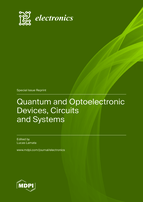Quantum and Optoelectronic Devices, Circuits and Systems
A special issue of Electronics (ISSN 2079-9292). This special issue belongs to the section "Quantum Electronics".
Deadline for manuscript submissions: closed (5 April 2023) | Viewed by 27861
Special Issue Editor
Interests: quantum optics; quantum information; theoretical physics; quantum simulations; trapped ion physics; superconducting circuits; entanglement classification; entanglement generation; quantum biomimetics; artificial intelligence; machine learning; embedding quantum simulators; penning traps; quantum photonics
Special Issues, Collections and Topics in MDPI journals
Special Issue Information
Dear Colleagues,
The fields of quantum electronics (e.g., superconducting circuits, quantum dots) as well as optoelectronics have produced much interest in the past few years. They deal with quantum and optical platforms in combination with electronic and condensed matter systems, which may serve as building blocks for a plethora of applications in quantum computing and optical technology.
This Special Issue is devoted to the dissemination of high-quality research on the topics of quantum and optoelectronics. Areas considered, but not exclusively, are quantum electronics, optoelectronics, quantum optics, superconducting circuits, quantum dots, and integrated quantum photonics. Both theoretical contributions, as well as experimental implementations, will be published. Connections to emerging topics such as machine learning and artificial intelligence for designing and controlling physical devices are also valued. Original articles, as well as reviews on specific fields, are welcome.
Prof. Dr. Lucas Lamata
Guest Editor
Manuscript Submission Information
Manuscripts should be submitted online at www.mdpi.com by registering and logging in to this website. Once you are registered, click here to go to the submission form. Manuscripts can be submitted until the deadline. All submissions that pass pre-check are peer-reviewed. Accepted papers will be published continuously in the journal (as soon as accepted) and will be listed together on the special issue website. Research articles, review articles as well as short communications are invited. For planned papers, a title and short abstract (about 100 words) can be sent to the Editorial Office for announcement on this website.
Submitted manuscripts should not have been published previously, nor be under consideration for publication elsewhere (except conference proceedings papers). All manuscripts are thoroughly refereed through a single-blind peer-review process. A guide for authors and other relevant information for submission of manuscripts is available on the Instructions for Authors page. Electronics is an international peer-reviewed open access semimonthly journal published by MDPI.
Please visit the Instructions for Authors page before submitting a manuscript. The Article Processing Charge (APC) for publication in this open access journal is 2400 CHF (Swiss Francs). Submitted papers should be well formatted and use good English. Authors may use MDPI's English editing service prior to publication or during author revisions.
Keywords
- quantum electronics
- optoelectronics
- quantum optics
- superconducting circuits
- quantum dots
- integrated quantum photonics






